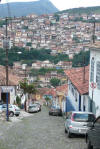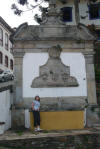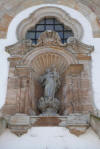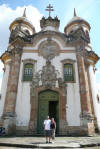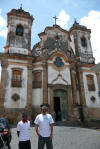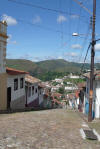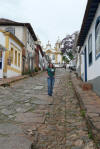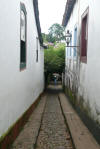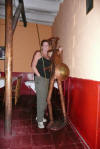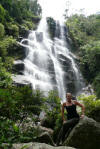Diary/Photo Journal
Week of January 13, 2008 (see page 8 for the
first half of the week)
After Congonhas, we rolled into the town we were most looking forward to, Ouro Preto (Black Gold). As with many other cities within Minas Gerais (and as you can guess by its name), Ouro Preto was a particularly important town during the gold rush days. The town itself was built between deep ravines and this led to steep, narrow and rather crooked streets that without a good map or a good sense of direction, has you turned around without your even knowing it.
Ouro Preto came to life around 1711 and at its heart, the town seems to be relatively unchanged. The city is still best traversed on foot and the original stone streets give you the necessary foothold as you make your way up and down the extremely steep lanes. Churches seem to dominate the skyline as there are 23 churches for this small enclave. And, as in Congonhas, Aleijadinho left several outstanding soapstone works of art on the church facades as well as inside the places of worship.
We made our way to the center of town and were immediately met by a eager and young man named Fabiano who proceeded to recommend a nearby pousada with parking. As we said we would take a look at the Pousada Ouro Preto, he began to step lively and beckon us to follow him. As he jogged down the bumpy hills for about 1/2 mile, he guided us through a narrow (and I mean narrow) path that came to an end at cliff-hugging pousada. We were sold right there and then.
Fabiano quickly launched into his sales pitch to use him as a guide and as the price was very good and he was so likable, we just could not resist. We met up with Fabiano dead on the appointed time and we opted to drive throughout the city and its outskirts so as to see more in the day.
As we felt Fabiano quite interesting, I wanted to tell his brief story. Fabiano left home at 10 years old as his parents were pushing him to work and ignore his studies. Even at that early age, he realized the importance of an education, so he left home and was helped out by his beloved grandfather (that lived to a grand old age of 112). By the age of 16, he had acquired his own apartment, tv, refrigerator, etc. and was working as a tour guide in between his studying.
As Fabiano wanted to take a special course that would certify him as a "Tour Technician", he sold everything he owned and completed the course. Now, at the ripe old age of 18, he is affectionately called "Professor" by his peers and is a fountain of historical and anecdotal information about Ouro Preto.
Fabiano took us to a small mine tour in which we gladly participated. Our mine guide was a plethora of information, oftentimes making Gerson wince as some of the things done to the slaves were rather "sensitive" to men. As we were told, small or short in stature slaves were coveted and even "cultivated". If a slave grew too tall, his balls would be crushed (insert Gerson's wince here) so as to keep him from creating any tall sons. If a slave was to be kept smaller, the mine owners would again crush the slave's balls (insert wince here) in order to prevent or restrict his progression into puberty (IE: keeping him from growing).
As for the female slaves, they were bred immediately upon their first menstruation (usually around 12 years of age) and were kept so until their death, many children later.
We visited the Igreja de Santa Efigenia dos Pretos, which was a church built by slaves for the slaves somewhere around 1745. As the church is not rich in gold, it does have a rather rich history. In order to fund the construction of the church, the slaves would find ways to trap the gold dust in their hair and under their fingernails and after their long hours underground, they would go the where the church was being built and wash their hair and hands in a common basin, leaving the gold dust behind. Thus, providing the funds for the church - quite smart if you ask me!
With still much more of the city to explore, lunchtime came upon us and Fabiano escorted us a ways out of town to a little place called Lavras Novas. This beautiful mountain town was created as a "quilombo" (communities formed by runaway slaves) and remains a peaceful and rustic reminder of a safe place for the slaves to hide. Fabiano took us to a fantastic little restaurant wherein you literally walked up to where the workers were cooking and spooned your preferred food onto your plate.
After lunch, we crept along a "road" out to a trailhead for a 30 minute hike to several natural pools. While there, we ran into several local boys enjoying their summer vacation by frolicking in the various piscinas. Of course, that included Gerson as well.
We made it back into town in time to walk through a museum and to visit a few more churches. As with the majority of colonial towns throughout the Americas, the churches hold the history because they held (IE: stole) the wealth.
Seeing as we almost adopted Fabiano, we met him for dinner and were told yet another story about one of his nicknames. Along with "Professor", he has also been dubbed "Ratinho" which fondly means "little rat". Apparently, because he was rather small, he was able to squeeze through the pipe openings into his school and he would sneak into the kitchen and abscond with some of the food. When the cooks realized that food was disappearing, they set a trap and caught him and affectionately called him "Ratinho". His face lighted up when he told the story and you could tell he loved those women that caught him.
After our terrific stay in Ouro Preto, we took a quick ride to Tiradentes, yet another historical town born of that illustrious golden mineral. The city's namesake hails from a change from Arrail da Ponta do Morro (Hamlet on a Hilltop) to Tiradentes, a hero of the Inconfidencia.
The Inconfidencia Mineira was founded by Joaquim Jose da Silva Xavier (nicknamed Tiradentes, meaning "tooth-puller" for his dentistry skills) and was a group set on rebellion against the Portuguese crown that was taking a large percentage of the gold monies through exorbitant taxation. The rebellion was crushed and several of the leaders were caught. Only Tiradentes refused to deny his role in the conspiracy, was abandoned by his friends and jailed for several years. Ultimately, he was taken to Rio de Janeiro where he was drawn and quartered (which means he would be hung until almost dead, disemboweled and emasculated and the entrails and genitalia burned before the still alive condemned's eyes, then beheaded and his torso cut into four parts).
From Tiradentes we headed back up into the mountains to Parque Nacional de Itatiaia (Ee-tat-ee-eye-a) and to what was for a long time thought to be the highest place in Brasil at 2400 meters (7875 feet). We found what we thought to be a dreamy little pousada that turned out to be a rather nightmarish place. Fortunately, we were able to catch the end of a beautiful day and hike up to a viewpoint to catch the sunset. Unfortunately, due to rather unruly young men camping nearby and their incessant talking and laughing and slamming car doors until the wee hours, we did not get much sleep. That coupled with a very dense fog in the morning dimmed our prospects for hiking.
With our disappointment up above, we very carefully picked our way back down the "road' and visited the lower part of the park. We hiked up to a pleasant waterfall and natural pool that seemed to a rather popular place for many of the tourists. We actually had more interest in the foliage and the butterflies as they were quite exceptional.
Within the park was a delicious restaurant that was part of a very nice pousada-chalets hotel. Our view was magnificent and it all but made up for our bad night before.
We finished our lunch and made our way further down the road to end up at a little enclave called Maromba. We loved it! It had a hippie vibe and very few amenities except a substantial amount of pousadas. Again, to escape the heat and humidity and as Gerson said, to come to a place where the Brazilians can actually "feel cold" and enjoy fireplaces, saunas and fondues, the people of the State of Rio de Janeiro frequent these mountain towns (Penedo, Visconde de Maua, Maringa and Maromba).
Wait until you see how we started next week! Let's just say we slid into a great week ;).
Home Page Brasil III Diary Index Previous Diary page Brasil III Diary page10



